
March 2023 Corporate Presentation Advancing Medicines for Solid Tumors
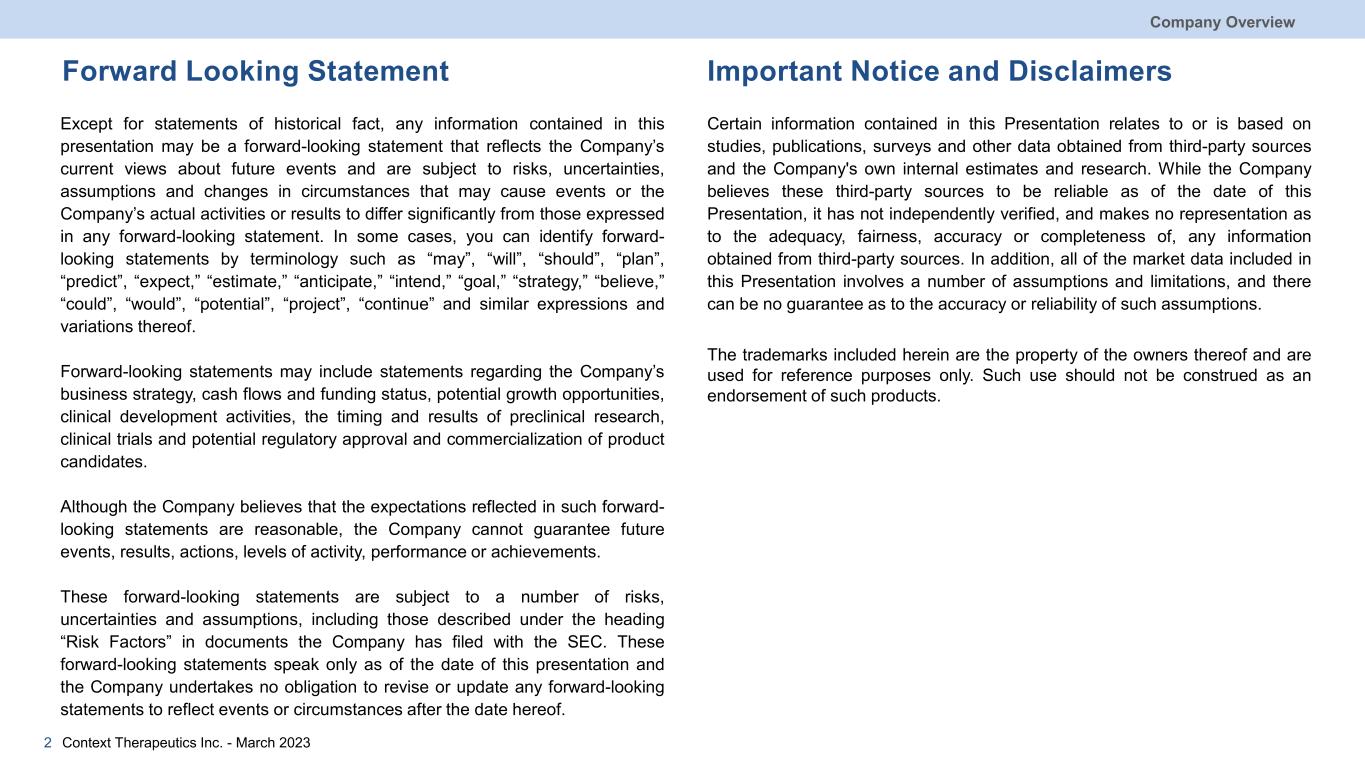
Important Notice and Disclaimers Except for statements of historical fact, any information contained in this presentation may be a forward-looking statement that reflects the Company’s current views about future events and are subject to risks, uncertainties, assumptions and changes in circumstances that may cause events or the Company’s actual activities or results to differ significantly from those expressed in any forward-looking statement. In some cases, you can identify forward- looking statements by terminology such as “may”, “will”, “should”, “plan”, “predict”, “expect,” “estimate,” “anticipate,” “intend,” “goal,” “strategy,” “believe,” “could”, “would”, “potential”, “project”, “continue” and similar expressions and variations thereof. Forward-looking statements may include statements regarding the Company’s business strategy, cash flows and funding status, potential growth opportunities, clinical development activities, the timing and results of preclinical research, clinical trials and potential regulatory approval and commercialization of product candidates. Although the Company believes that the expectations reflected in such forward- looking statements are reasonable, the Company cannot guarantee future events, results, actions, levels of activity, performance or achievements. These forward-looking statements are subject to a number of risks, uncertainties and assumptions, including those described under the heading “Risk Factors” in documents the Company has filed with the SEC. These forward-looking statements speak only as of the date of this presentation and the Company undertakes no obligation to revise or update any forward-looking statements to reflect events or circumstances after the date hereof. 2 Context Therapeutics Inc. - March 2023 Certain information contained in this Presentation relates to or is based on studies, publications, surveys and other data obtained from third-party sources and the Company's own internal estimates and research. While the Company believes these third-party sources to be reliable as of the date of this Presentation, it has not independently verified, and makes no representation as to the adequacy, fairness, accuracy or completeness of, any information obtained from third-party sources. In addition, all of the market data included in this Presentation involves a number of assumptions and limitations, and there can be no guarantee as to the accuracy or reliability of such assumptions. The trademarks included herein are the property of the owners thereof and are used for reference purposes only. Such use should not be construed as an endorsement of such products. Forward Looking Statement Company Overview
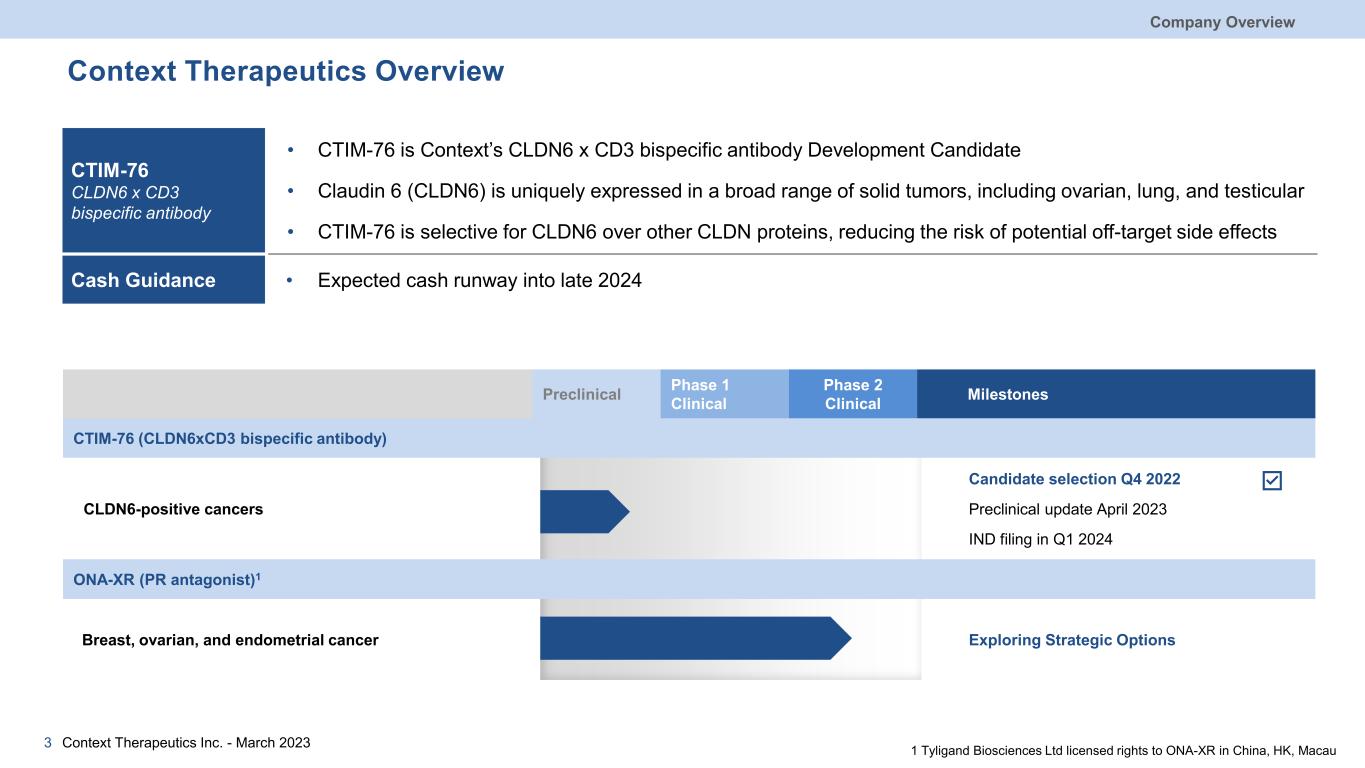
Context Therapeutics Overview Context Therapeutics Inc. - March 20233 Company Overview CTIM-76 CLDN6 x CD3 bispecific antibody • CTIM-76 is Context’s CLDN6 x CD3 bispecific antibody Development Candidate • Claudin 6 (CLDN6) is uniquely expressed in a broad range of solid tumors, including ovarian, lung, and testicular • CTIM-76 is selective for CLDN6 over other CLDN proteins, reducing the risk of potential off-target side effects Cash Guidance • Expected cash runway into late 2024 Preclinical Phase 1 Clinical Phase 2 Clinical Milestones CTIM-76 (CLDN6xCD3 bispecific antibody) CLDN6-positive cancers Candidate selection Q4 2022 Preclinical update April 2023 IND filing in Q1 2024 ONA-XR (PR antagonist)1 Breast, ovarian, and endometrial cancer Exploring Strategic Options 1 Tyligand Biosciences Ltd licensed rights to ONA-XR in China, HK, Macau
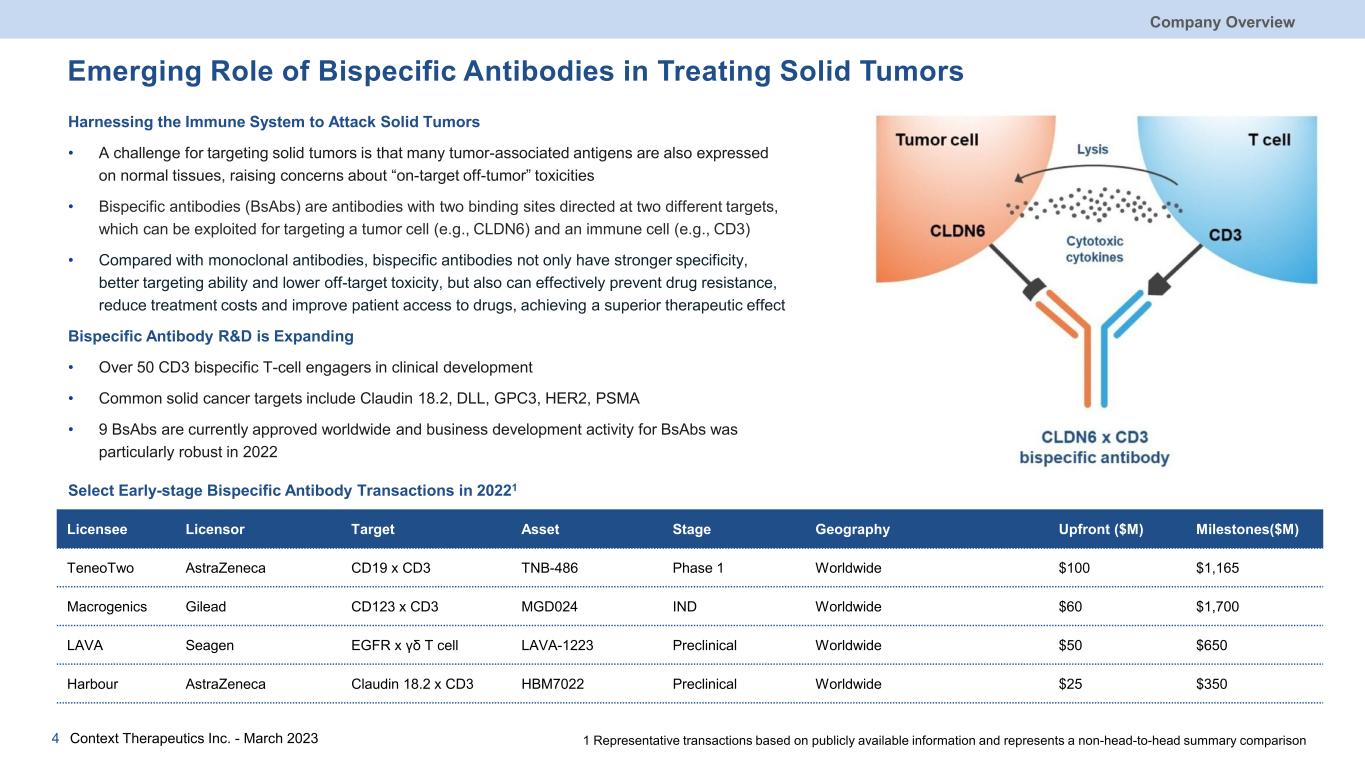
Emerging Role of Bispecific Antibodies in Treating Solid Tumors Harnessing the Immune System to Attack Solid Tumors • A challenge for targeting solid tumors is that many tumor-associated antigens are also expressed on normal tissues, raising concerns about “on-target off-tumor” toxicities • Bispecific antibodies (BsAbs) are antibodies with two binding sites directed at two different targets, which can be exploited for targeting a tumor cell (e.g., CLDN6) and an immune cell (e.g., CD3) • Compared with monoclonal antibodies, bispecific antibodies not only have stronger specificity, better targeting ability and lower off-target toxicity, but also can effectively prevent drug resistance, reduce treatment costs and improve patient access to drugs, achieving a superior therapeutic effect Bispecific Antibody R&D is Expanding • Over 50 CD3 bispecific T-cell engagers in clinical development • Common solid cancer targets include Claudin 18.2, DLL, GPC3, HER2, PSMA • 9 BsAbs are currently approved worldwide and business development activity for BsAbs was particularly robust in 2022 Context Therapeutics Inc. - March 20234 Licensee Licensor Target Asset Stage Geography Upfront ($M) Milestones($M) TeneoTwo AstraZeneca CD19 x CD3 TNB-486 Phase 1 Worldwide $100 $1,165 Macrogenics Gilead CD123 x CD3 MGD024 IND Worldwide $60 $1,700 LAVA Seagen EGFR x γδ T cell LAVA-1223 Preclinical Worldwide $50 $650 Harbour AstraZeneca Claudin 18.2 x CD3 HBM7022 Preclinical Worldwide $25 $350 1 Representative transactions based on publicly available information and represents a non-head-to-head summary comparison Select Early-stage Bispecific Antibody Transactions in 20221 Company Overview
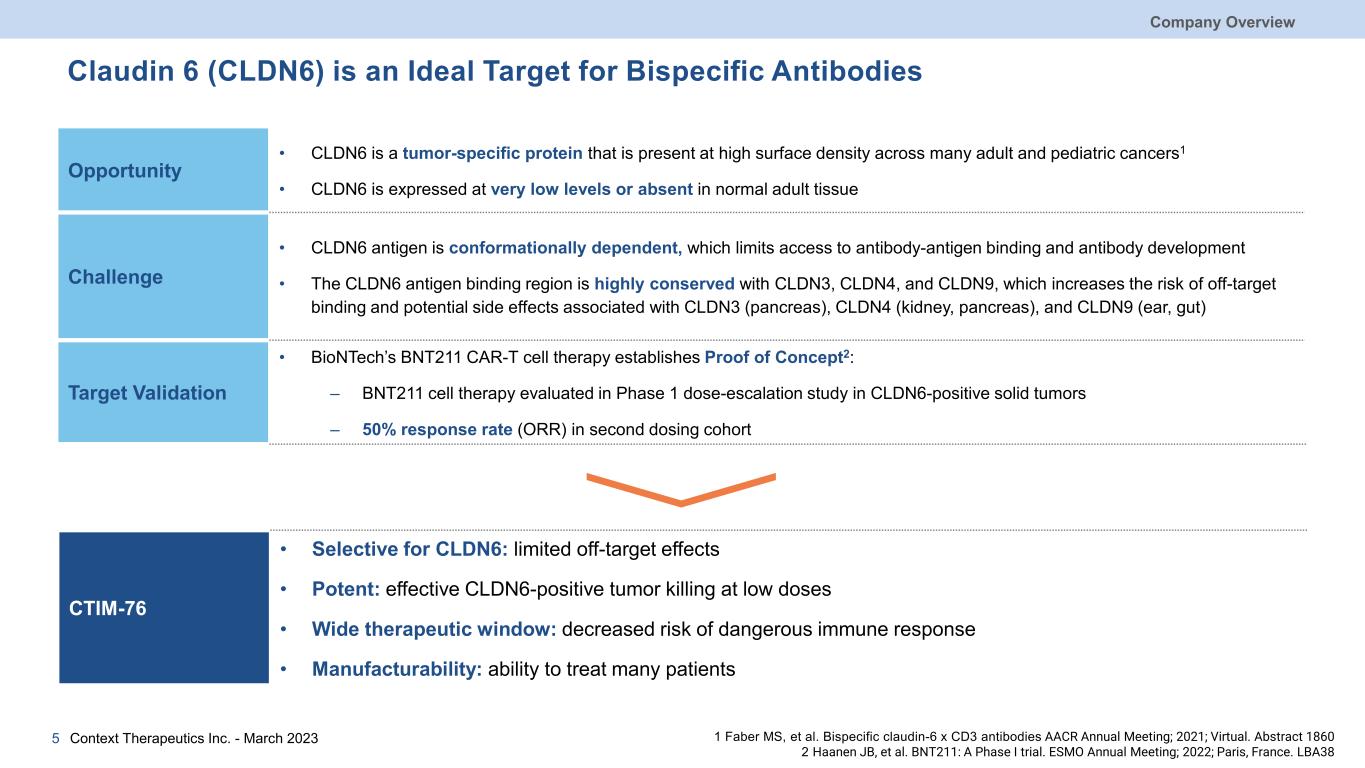
Claudin 6 (CLDN6) is an Ideal Target for Bispecific Antibodies Opportunity • CLDN6 is a tumor-specific protein that is present at high surface density across many adult and pediatric cancers1 • CLDN6 is expressed at very low levels or absent in normal adult tissue Challenge • CLDN6 antigen is conformationally dependent, which limits access to antibody-antigen binding and antibody development • The CLDN6 antigen binding region is highly conserved with CLDN3, CLDN4, and CLDN9, which increases the risk of off-target binding and potential side effects associated with CLDN3 (pancreas), CLDN4 (kidney, pancreas), and CLDN9 (ear, gut) Target Validation • BioNTech’s BNT211 CAR-T cell therapy establishes Proof of Concept2: ‒ BNT211 cell therapy evaluated in Phase 1 dose-escalation study in CLDN6-positive solid tumors ‒ 50% response rate (ORR) in second dosing cohort Company Overview Context Therapeutics Inc. - March 20235 1 Faber MS, et al. Bispecific claudin-6 x CD3 antibodies AACR Annual Meeting; 2021; Virtual. Abstract 1860 2 Haanen JB, et al. BNT211: A Phase I trial. ESMO Annual Meeting; 2022; Paris, France. LBA38 CTIM-76 • Selective for CLDN6: limited off-target effects • Potent: effective CLDN6-positive tumor killing at low doses • Wide therapeutic window: decreased risk of dangerous immune response • Manufacturability: ability to treat many patients
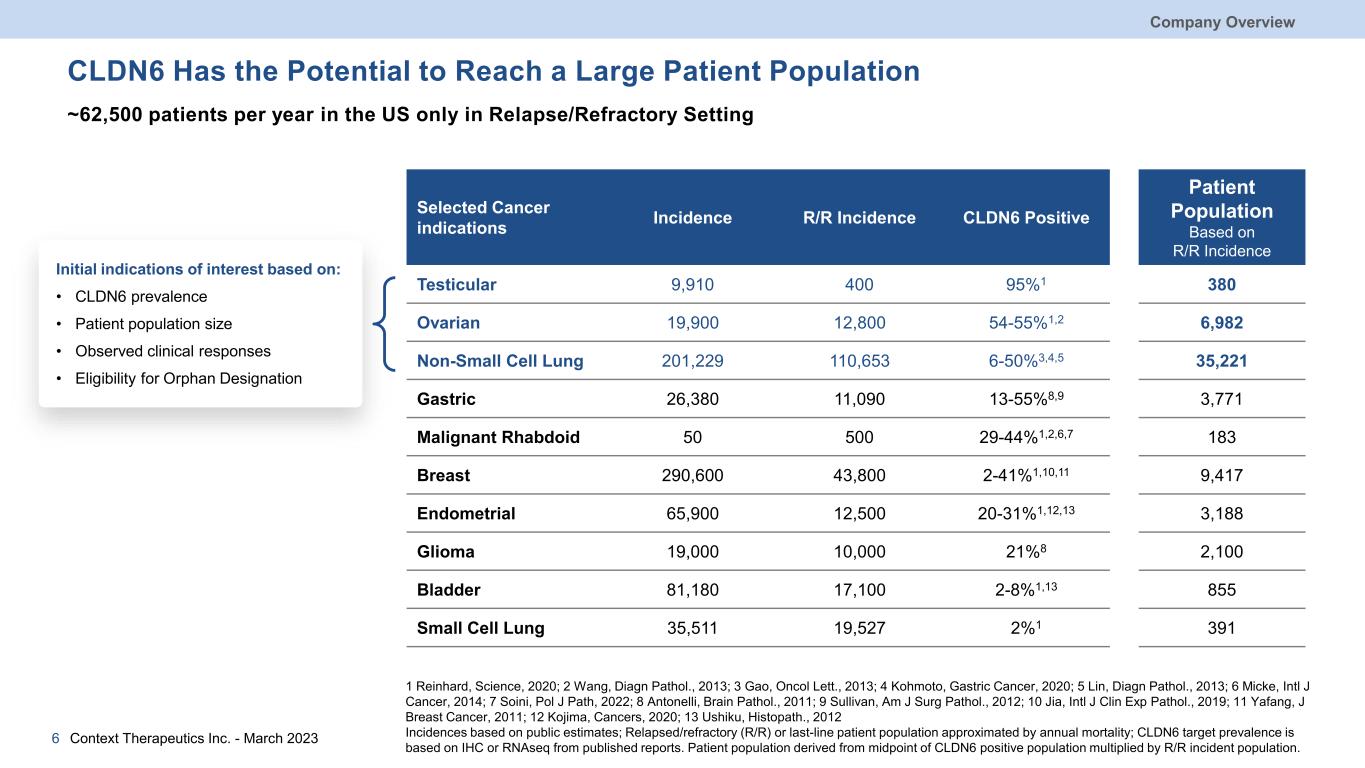
CLDN6 Has the Potential to Reach a Large Patient Population ~62,500 patients per year in the US only in Relapse/Refractory Setting Company Overview 6 Selected Cancer indications Incidence R/R Incidence CLDN6 Positive Patient Population Based on R/R Incidence Testicular 9,910 400 95%1 380 Ovarian 19,900 12,800 54-55%1,2 6,982 Non-Small Cell Lung 201,229 110,653 6-50%3,4,5 35,221 Gastric 26,380 11,090 13-55%8,9 3,771 Malignant Rhabdoid 50 500 29-44%1,2,6,7 183 Breast 290,600 43,800 2-41%1,10,11 9,417 Endometrial 65,900 12,500 20-31%1,12,13 3,188 Glioma 19,000 10,000 21%8 2,100 Bladder 81,180 17,100 2-8%1,13 855 Small Cell Lung 35,511 19,527 2%1 391 1 Reinhard, Science, 2020; 2 Wang, Diagn Pathol., 2013; 3 Gao, Oncol Lett., 2013; 4 Kohmoto, Gastric Cancer, 2020; 5 Lin, Diagn Pathol., 2013; 6 Micke, Intl J Cancer, 2014; 7 Soini, Pol J Path, 2022; 8 Antonelli, Brain Pathol., 2011; 9 Sullivan, Am J Surg Pathol., 2012; 10 Jia, Intl J Clin Exp Pathol., 2019; 11 Yafang, J Breast Cancer, 2011; 12 Kojima, Cancers, 2020; 13 Ushiku, Histopath., 2012 Incidences based on public estimates; Relapsed/refractory (R/R) or last-line patient population approximated by annual mortality; CLDN6 target prevalence is based on IHC or RNAseq from published reports. Patient population derived from midpoint of CLDN6 positive population multiplied by R/R incident population. Initial indications of interest based on: • CLDN6 prevalence • Patient population size • Observed clinical responses • Eligibility for Orphan Designation Context Therapeutics Inc. - March 2023
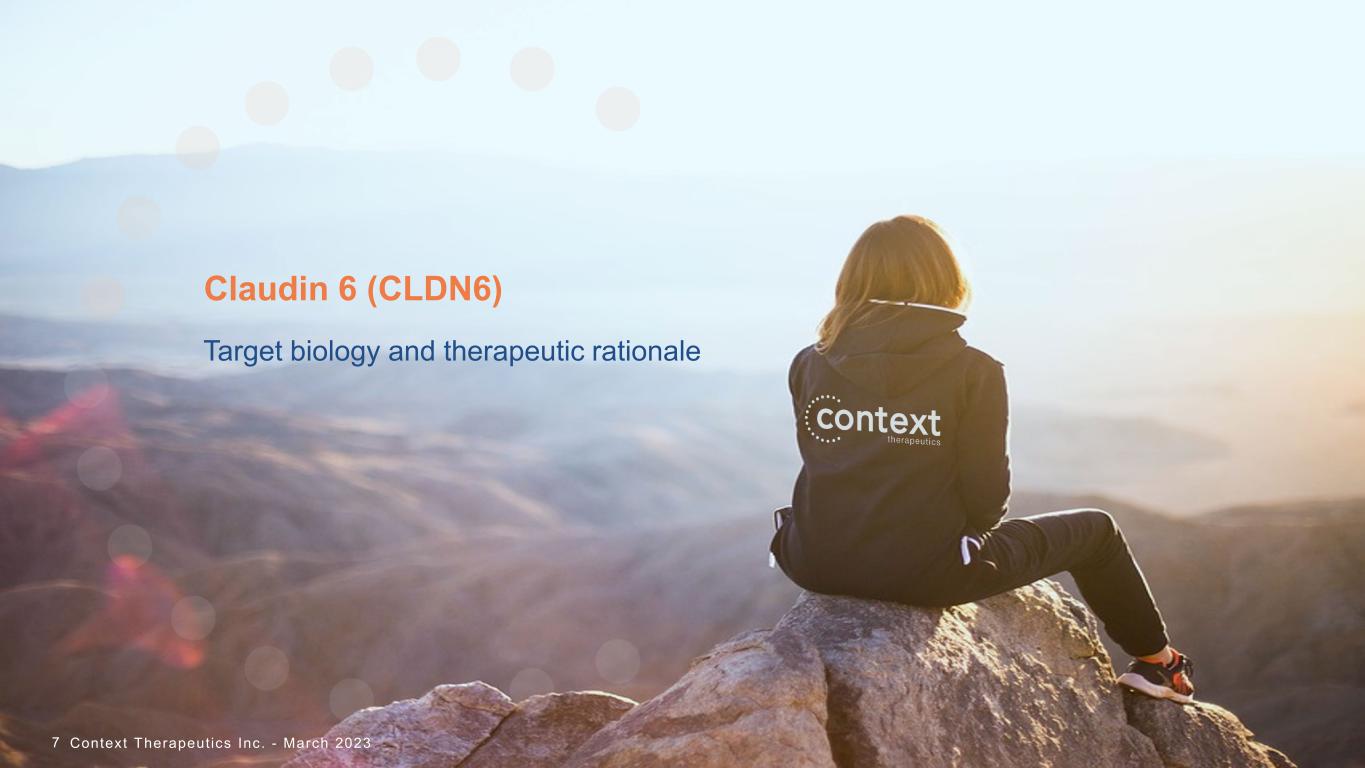
Claudin 6 (CLDN6) Target biology and therapeutic rationale Context Therapeutics Inc. - March 20237
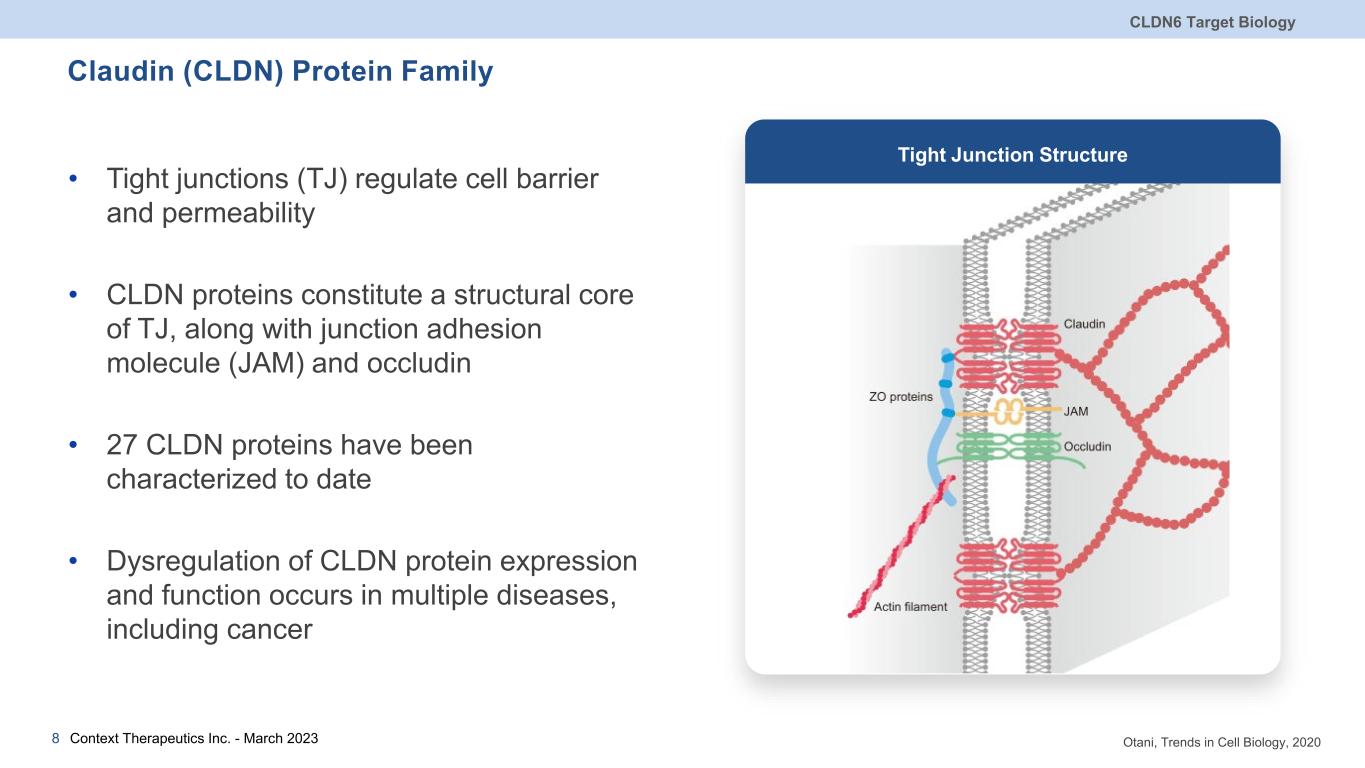
Claudin (CLDN) Protein Family • Tight junctions (TJ) regulate cell barrier and permeability • CLDN proteins constitute a structural core of TJ, along with junction adhesion molecule (JAM) and occludin • 27 CLDN proteins have been characterized to date • Dysregulation of CLDN protein expression and function occurs in multiple diseases, including cancer CLDN6 Target Biology Context Therapeutics Inc. - March 20238 Otani, Trends in Cell Biology, 2020 Tight Junction Structure
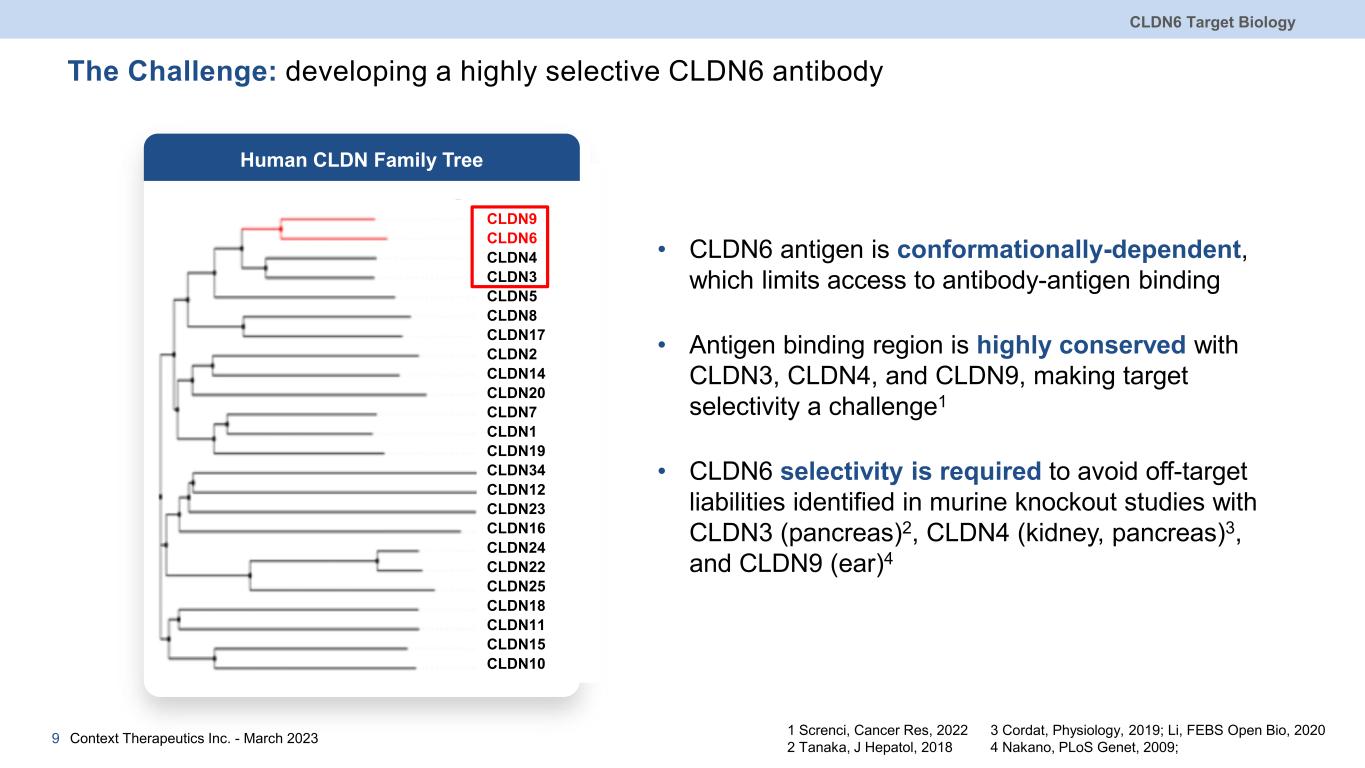
The Challenge: developing a highly selective CLDN6 antibody CLDN6 Target Biology Context Therapeutics Inc. - March 20239 CLDN9 CLDN6 CLDN4 CLDN3 CLDN5 CLDN8 CLDN17 CLDN2 CLDN14 CLDN20 CLDN7 CLDN1 CLDN19 CLDN34 CLDN12 CLDN23 CLDN16 CLDN24 CLDN22 CLDN25 CLDN18 CLDN11 CLDN15 CLDN10 • CLDN6 antigen is conformationally-dependent, which limits access to antibody-antigen binding • Antigen binding region is highly conserved with CLDN3, CLDN4, and CLDN9, making target selectivity a challenge1 • CLDN6 selectivity is required to avoid off-target liabilities identified in murine knockout studies with CLDN3 (pancreas)2, CLDN4 (kidney, pancreas)3, and CLDN9 (ear)4 3 Cordat, Physiology, 2019; Li, FEBS Open Bio, 2020 4 Nakano, PLoS Genet, 2009; 1 Screnci, Cancer Res, 2022 2 Tanaka, J Hepatol, 2018 Human CLDN Family Tree
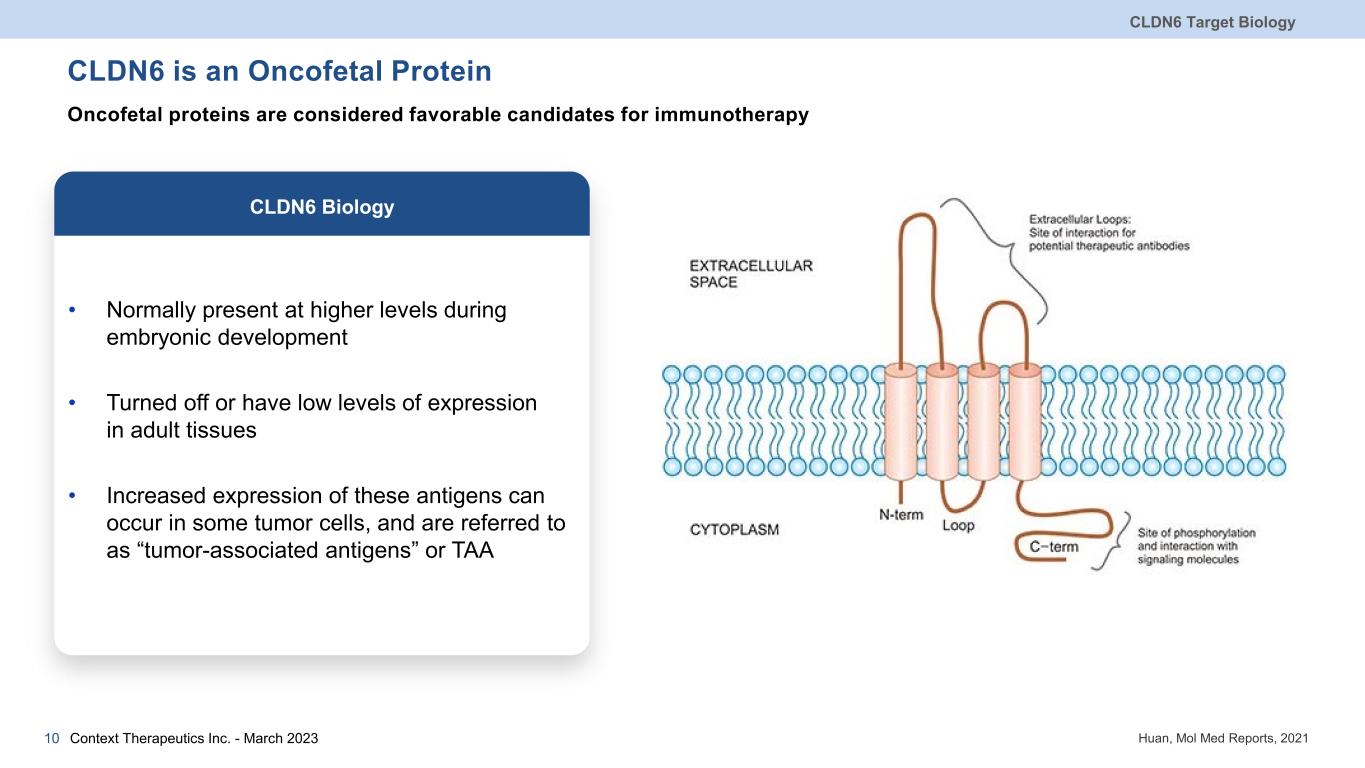
CLDN6 is an Oncofetal Protein Oncofetal proteins are considered favorable candidates for immunotherapy • Normally present at higher levels during embryonic development • Turned off or have low levels of expression in adult tissues • Increased expression of these antigens can occur in some tumor cells, and are referred to as “tumor-associated antigens” or TAA CLDN6 Target Biology Context Therapeutics Inc. - March 202310 CLDN6 Biology Huan, Mol Med Reports, 2021
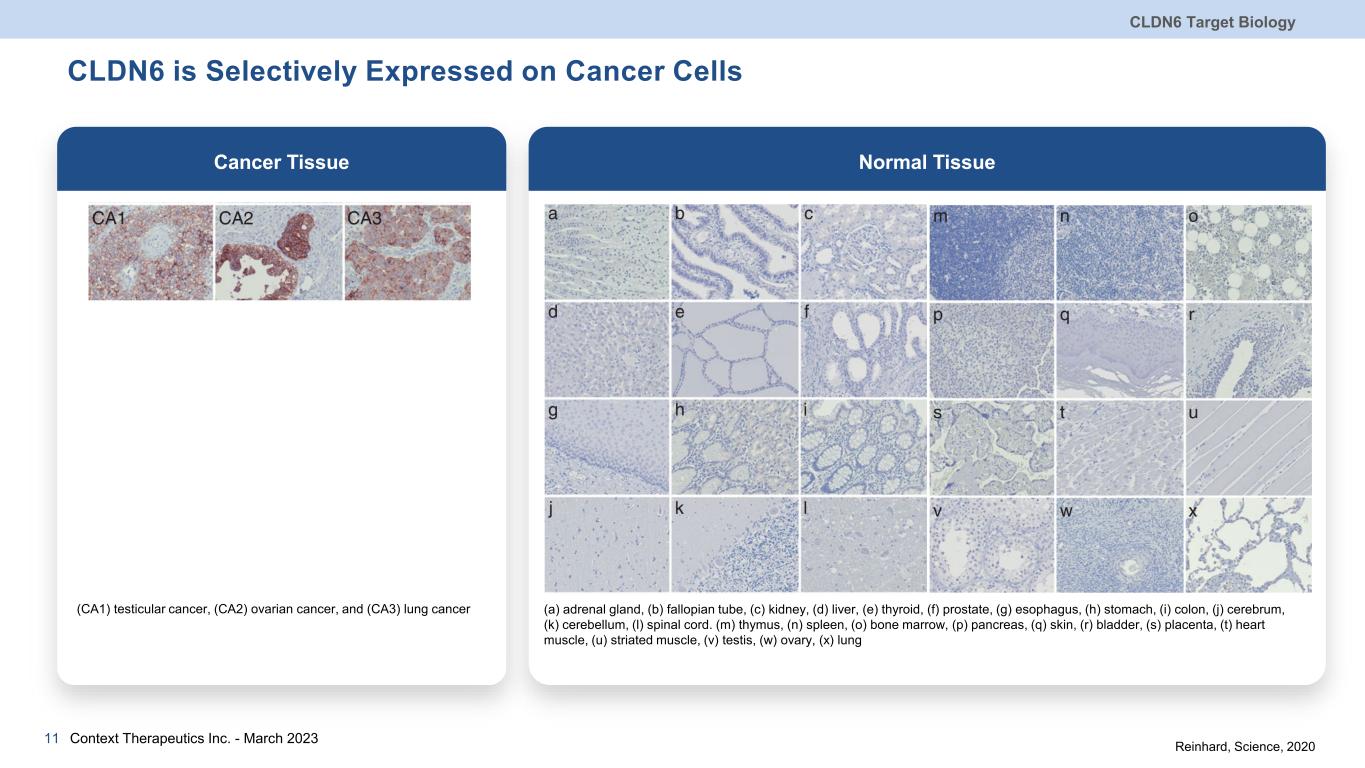
CLDN6 is Selectively Expressed on Cancer Cells CLDN6 Target Biology Context Therapeutics Inc. - March 202311 (a) adrenal gland, (b) fallopian tube, (c) kidney, (d) liver, (e) thyroid, (f) prostate, (g) esophagus, (h) stomach, (i) colon, (j) cerebrum, (k) cerebellum, (l) spinal cord. (m) thymus, (n) spleen, (o) bone marrow, (p) pancreas, (q) skin, (r) bladder, (s) placenta, (t) heart muscle, (u) striated muscle, (v) testis, (w) ovary, (x) lung (CA1) testicular cancer, (CA2) ovarian cancer, and (CA3) lung cancer Reinhard, Science, 2020 Normal TissueCancer Tissue
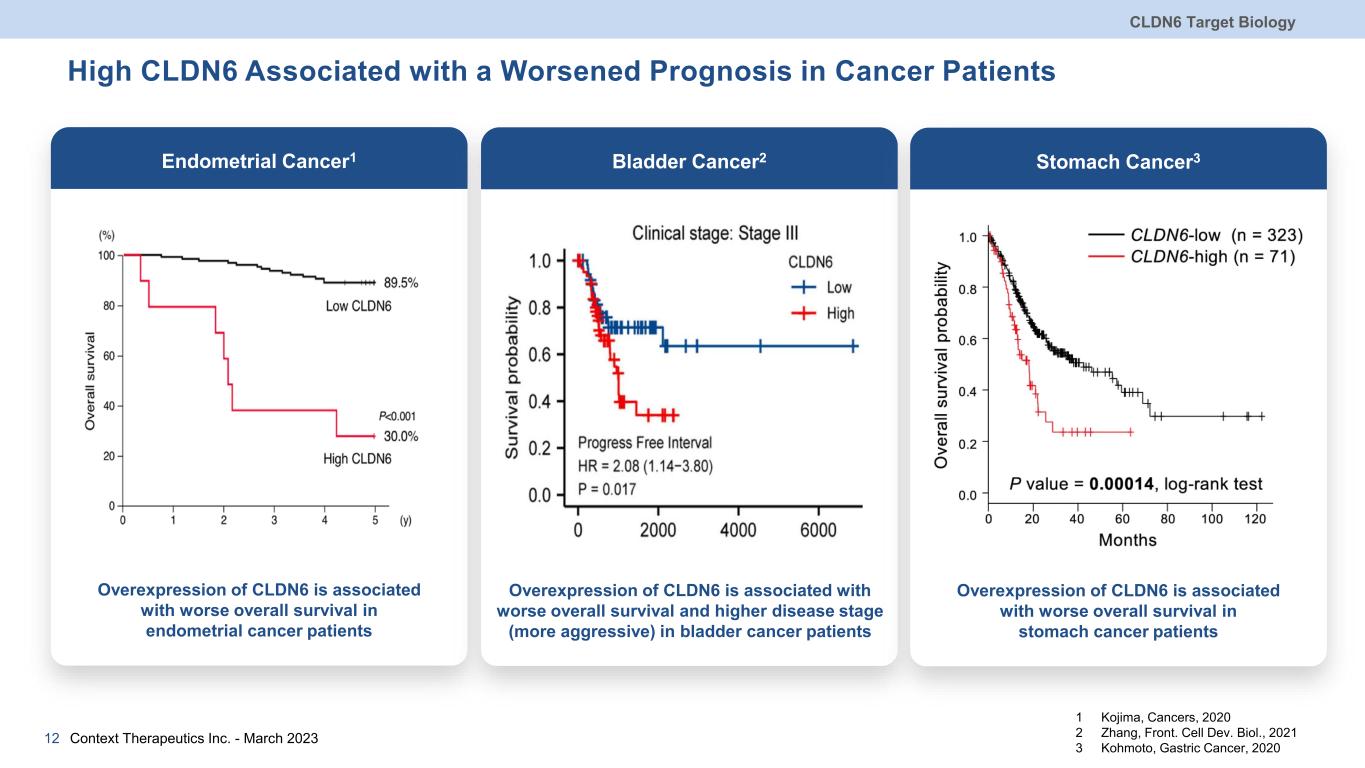
High CLDN6 Associated with a Worsened Prognosis in Cancer Patients CLDN6 Target Biology Context Therapeutics Inc. - March 202312 Endometrial Cancer1 Overexpression of CLDN6 is associated with worse overall survival in endometrial cancer patients 1 Kojima, Cancers, 2020 2 Zhang, Front. Cell Dev. Biol., 2021 3 Kohmoto, Gastric Cancer, 2020 Bladder Cancer2 Overexpression of CLDN6 is associated with worse overall survival and higher disease stage (more aggressive) in bladder cancer patients Stomach Cancer3 Overexpression of CLDN6 is associated with worse overall survival in stomach cancer patients
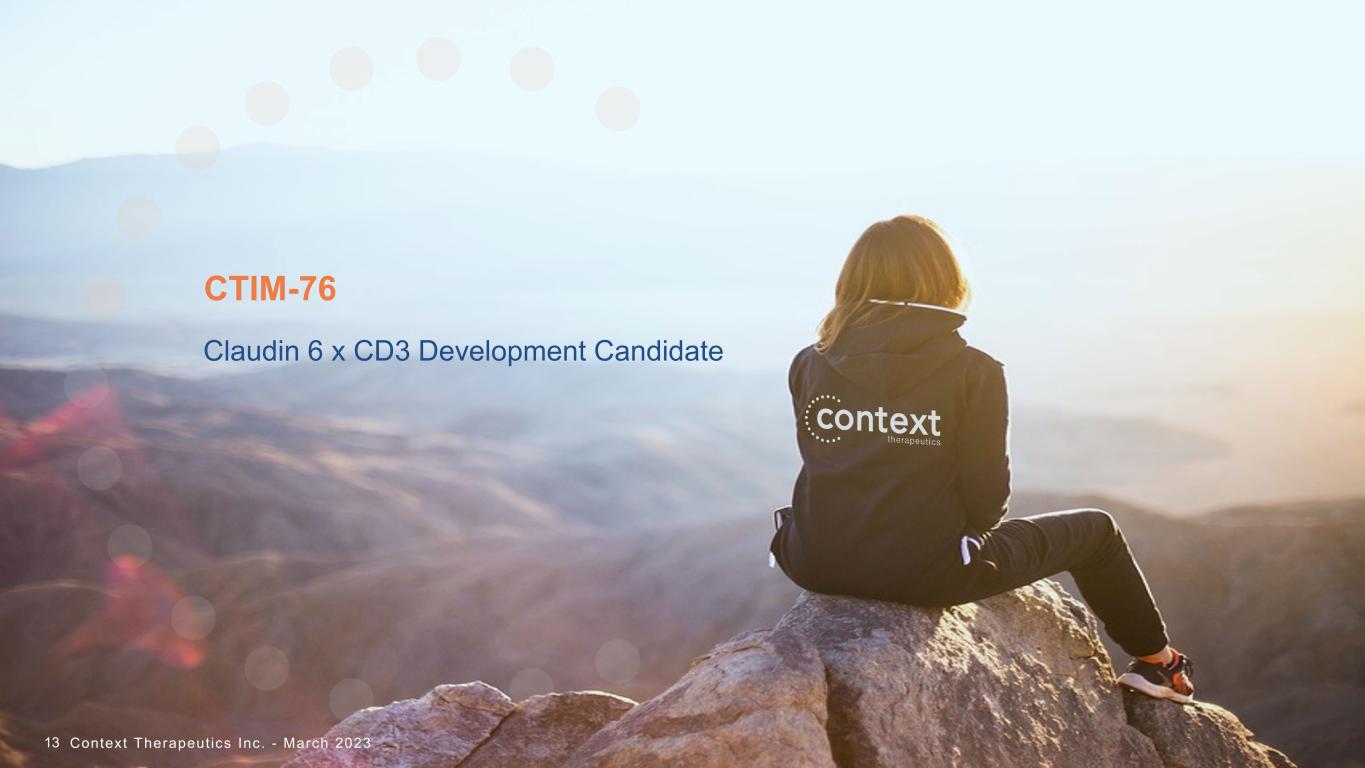
CTIM-76 Claudin 6 x CD3 Development Candidate Context Therapeutics Inc. - March 202313
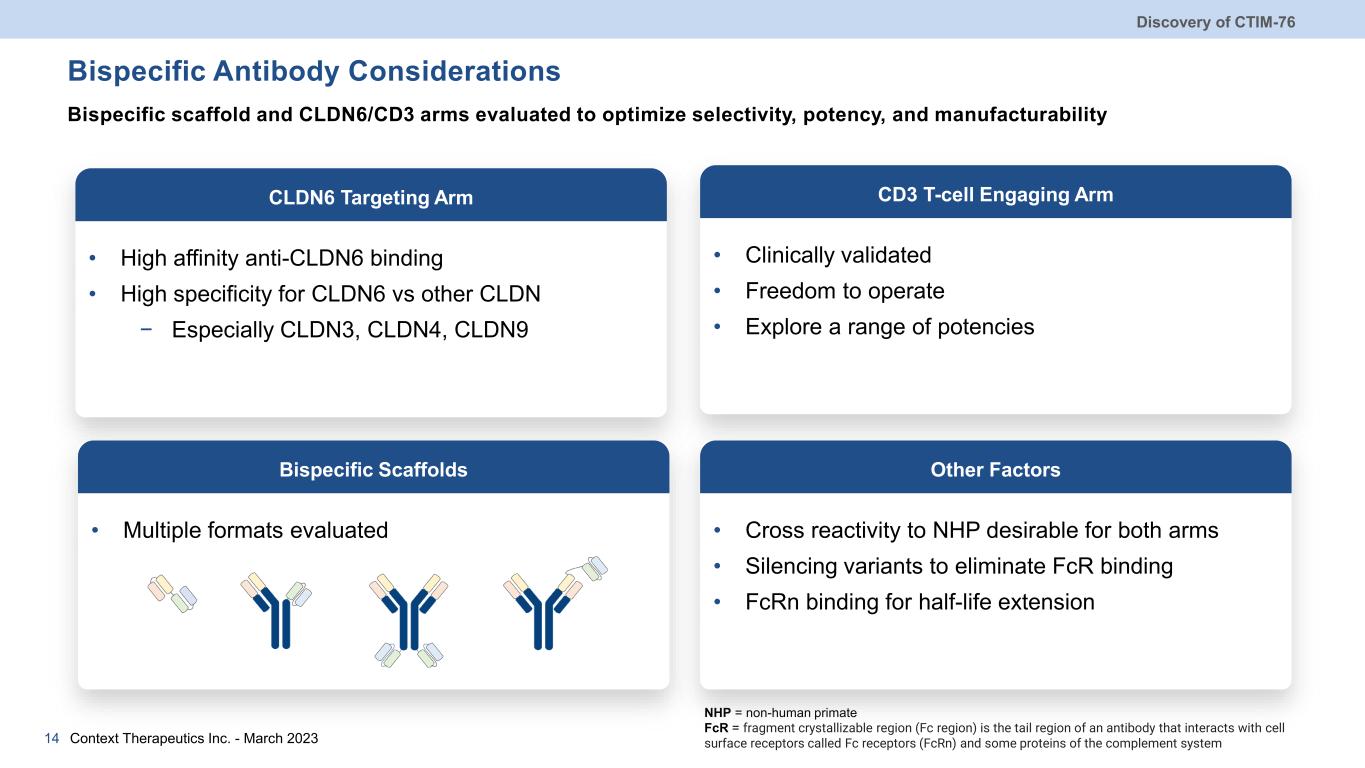
• Multiple formats evaluated Bispecific Antibody Considerations Bispecific scaffold and CLDN6/CD3 arms evaluated to optimize selectivity, potency, and manufacturability Discovery of CTIM-76 Context Therapeutics Inc. - March 202314 NHP = non-human primate FcR = fragment crystallizable region (Fc region) is the tail region of an antibody that interacts with cell surface receptors called Fc receptors (FcRn) and some proteins of the complement system • High affinity anti-CLDN6 binding • High specificity for CLDN6 vs other CLDN − Especially CLDN3, CLDN4, CLDN9 CLDN6 Targeting Arm • Clinically validated • Freedom to operate • Explore a range of potencies CD3 T-cell Engaging Arm Bispecific Scaffolds • Cross reactivity to NHP desirable for both arms • Silencing variants to eliminate FcR binding • FcRn binding for half-life extension Other Factors
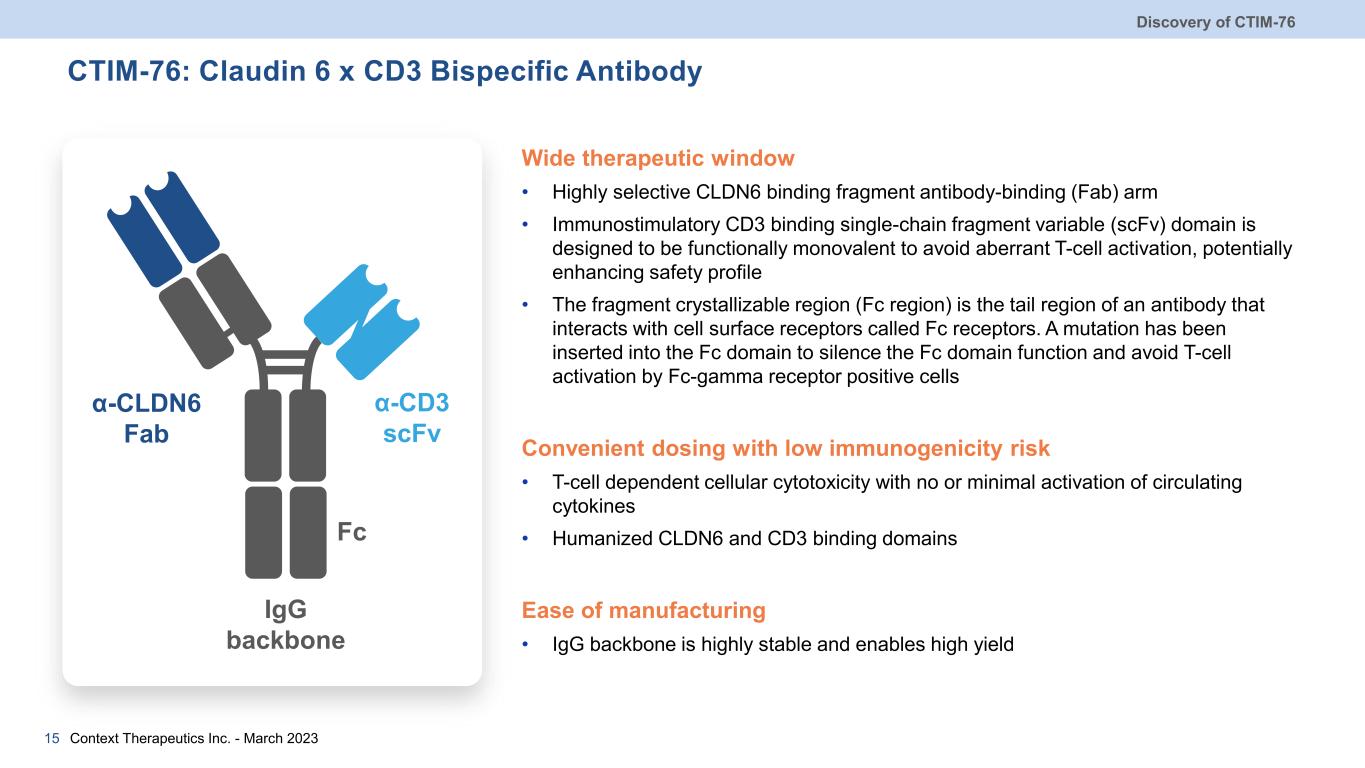
CTIM-76: Claudin 6 x CD3 Bispecific Antibody Wide therapeutic window • Highly selective CLDN6 binding fragment antibody-binding (Fab) arm • Immunostimulatory CD3 binding single-chain fragment variable (scFv) domain is designed to be functionally monovalent to avoid aberrant T-cell activation, potentially enhancing safety profile • The fragment crystallizable region (Fc region) is the tail region of an antibody that interacts with cell surface receptors called Fc receptors. A mutation has been inserted into the Fc domain to silence the Fc domain function and avoid T-cell activation by Fc-gamma receptor positive cells Convenient dosing with low immunogenicity risk • T-cell dependent cellular cytotoxicity with no or minimal activation of circulating cytokines • Humanized CLDN6 and CD3 binding domains Ease of manufacturing • IgG backbone is highly stable and enables high yield Discovery of CTIM-76 Context Therapeutics Inc. - March 202315 α-CLDN6 Fab α-CD3 scFv IgG backbone Fc
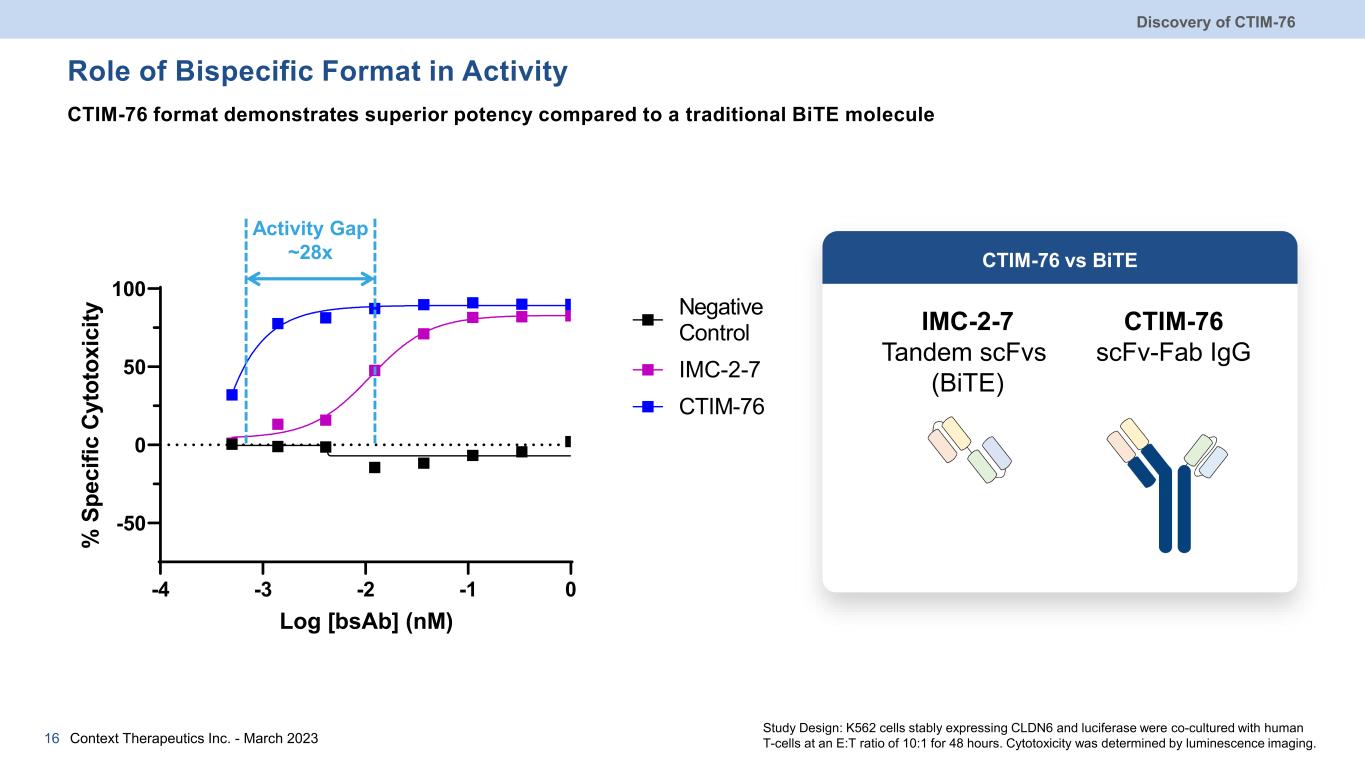
Role of Bispecific Format in Activity CTIM-76 format demonstrates superior potency compared to a traditional BiTE molecule Discovery of CTIM-76 Context Therapeutics Inc. - March 202316 -4 -3 -2 -1 0 -50 0 50 100 Log [bsAb] (nM) % S pe ci fic C yt ot ox ic ity Negative Control IMC-2-7 CTIM-76 IMC-2-7 Tandem scFvs (BiTE) CTIM-76 scFv-Fab IgG Study Design: K562 cells stably expressing CLDN6 and luciferase were co-cultured with human T-cells at an E:T ratio of 10:1 for 48 hours. Cytotoxicity was determined by luminescence imaging. Activity Gap ~28x CTIM-76 vs BiTE

Identification of Selective CLDN6 MAbs Discovery of CTIM-76 Context Therapeutics Inc. - March 202317 • IM301 (CLDN6 arm of CTIM-76) exhibits high CLDN6 selectivity1 • Epitope mapping of IM301 identifies unique binding location relative to benchmark IMAB027/ASP150 (Ganymed/Astellas) IMAB027/ASP1650 IM301 1 Screnci, iScience, 2022
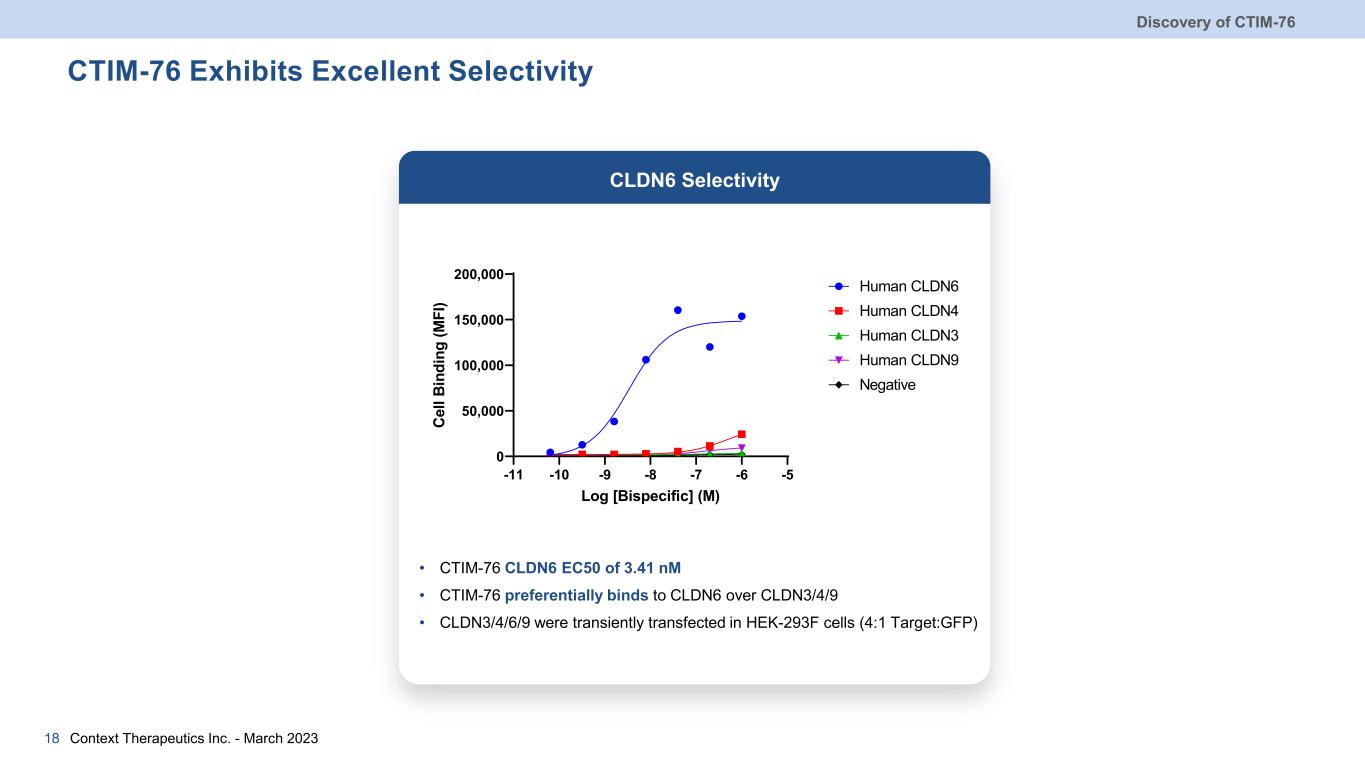
CTIM-76 Exhibits Excellent Selectivity Discovery of CTIM-76 Context Therapeutics Inc. - March 202318 • CTIM-76 CLDN6 EC50 of 3.41 nM • CTIM-76 preferentially binds to CLDN6 over CLDN3/4/9 • CLDN3/4/6/9 were transiently transfected in HEK-293F cells (4:1 Target:GFP) CLDN6 Selectivity -11 -10 -9 -8 -7 -6 -5 0 50,000 100,000 150,000 200,000 Log [Bispecific] (M) Ce ll Bi nd in g (M FI ) Human CLDN6 Human CLDN4 Human CLDN3 Human CLDN9 Negative
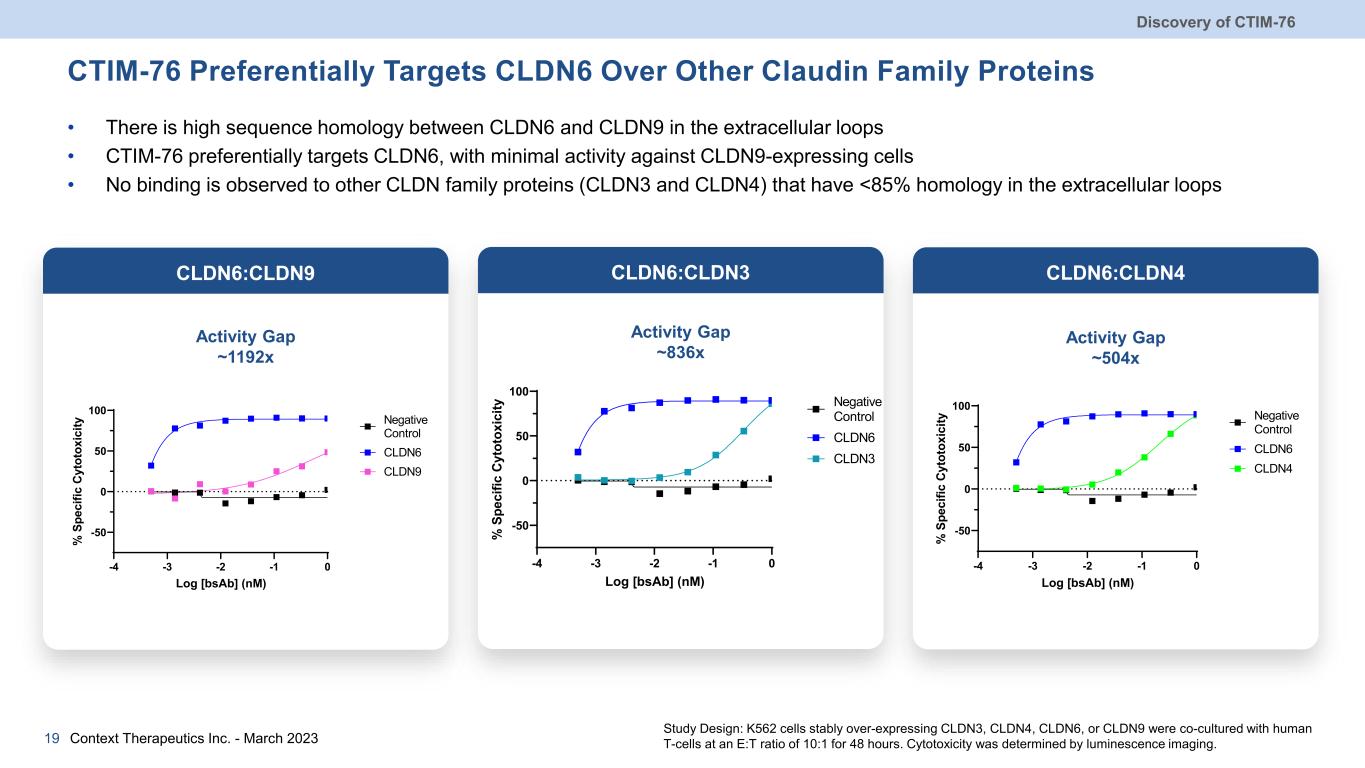
CTIM-76 Preferentially Targets CLDN6 Over Other Claudin Family Proteins Discovery of CTIM-76 Context Therapeutics Inc. - March 202319 • There is high sequence homology between CLDN6 and CLDN9 in the extracellular loops • CTIM-76 preferentially targets CLDN6, with minimal activity against CLDN9-expressing cells • No binding is observed to other CLDN family proteins (CLDN3 and CLDN4) that have <85% homology in the extracellular loops Study Design: K562 cells stably over-expressing CLDN3, CLDN4, CLDN6, or CLDN9 were co-cultured with human T-cells at an E:T ratio of 10:1 for 48 hours. Cytotoxicity was determined by luminescence imaging. CLDN6:CLDN3 CLDN6:CLDN4 -4 -3 -2 -1 0 -50 0 50 100 Log [bsAb] (nM) % S pe ci fic C yt ot ox ic ity Negative Control CLDN6 CLDN3 -4 -3 -2 -1 0 -50 0 50 100 Log [bsAb] (nM) % S pe ci fic C yt ot ox ic ity Negative Control CLDN6 CLDN4 Activity Gap ~836x Activity Gap ~504x CLDN6:CLDN9 -4 -3 -2 -1 0 -50 0 50 100 Log [bsAb] (nM) % S pe ci fic C yt ot ox ic ity Negative Control CLDN6 CLDN9 Activity Gap ~1192x
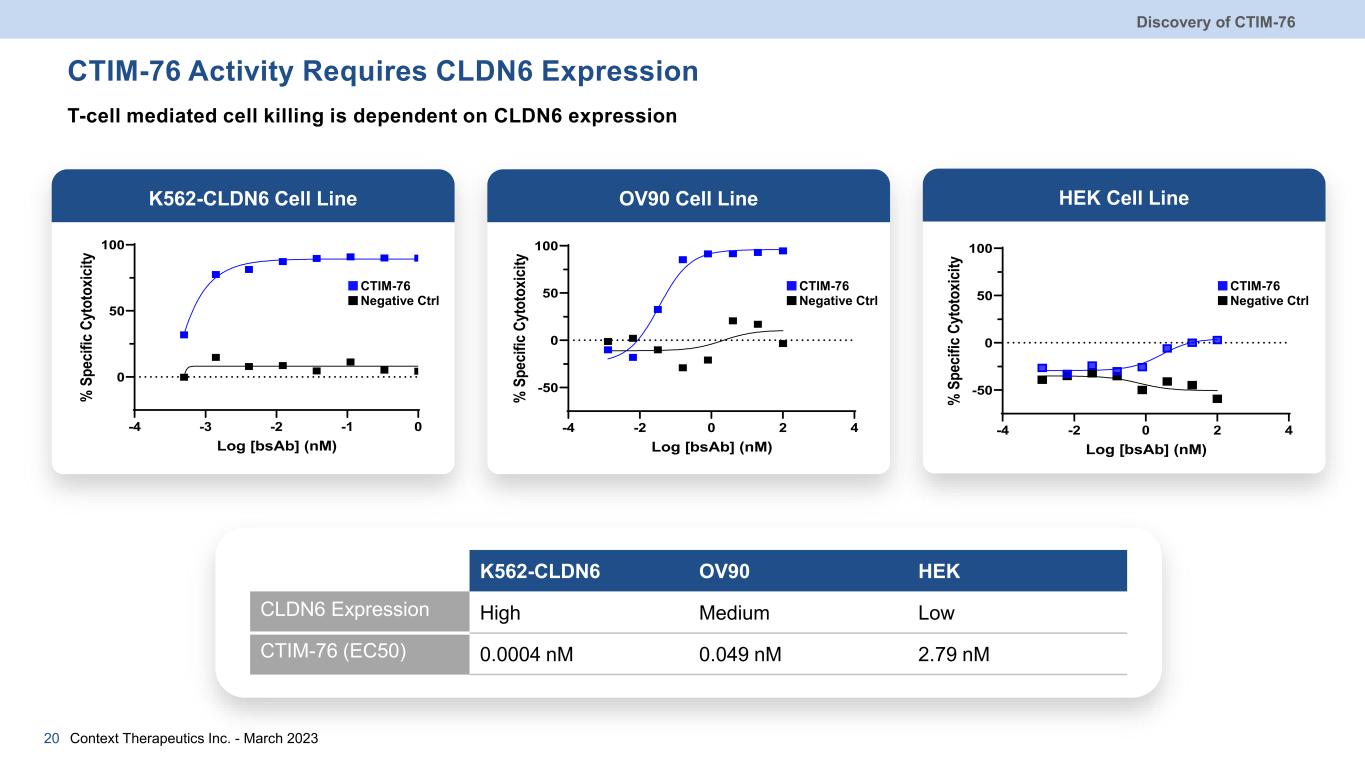
CTIM-76 Activity Requires CLDN6 Expression T-cell mediated cell killing is dependent on CLDN6 expression Discovery of CTIM-76 Context Therapeutics Inc. - March 202320 K562-CLDN6 OV90 HEK CLDN6 Expression High Medium Low CTIM-76 (EC50) 0.0004 nM 0.049 nM 2.79 nM OV90 Cell LineK562-CLDN6 Cell Line HEK Cell Line -4 -3 -2 -1 0 0 50 100 Log [bsAb] (nM) % S pe ci fic C yt ot ox ic ity CTIM-76 Negative Ctrl -4 -2 0 2 4 -50 0 50 100 Log [bsAb] (nM) % S pe cif ic Cy to to xic ity -4 -2 0 2 4 -50 0 50 100 Log [bsAb] (nM) % S pe cif ic Cy to to xic ity CTIM-76 Negative Ctrl CTIM-76 Negative Ctrl
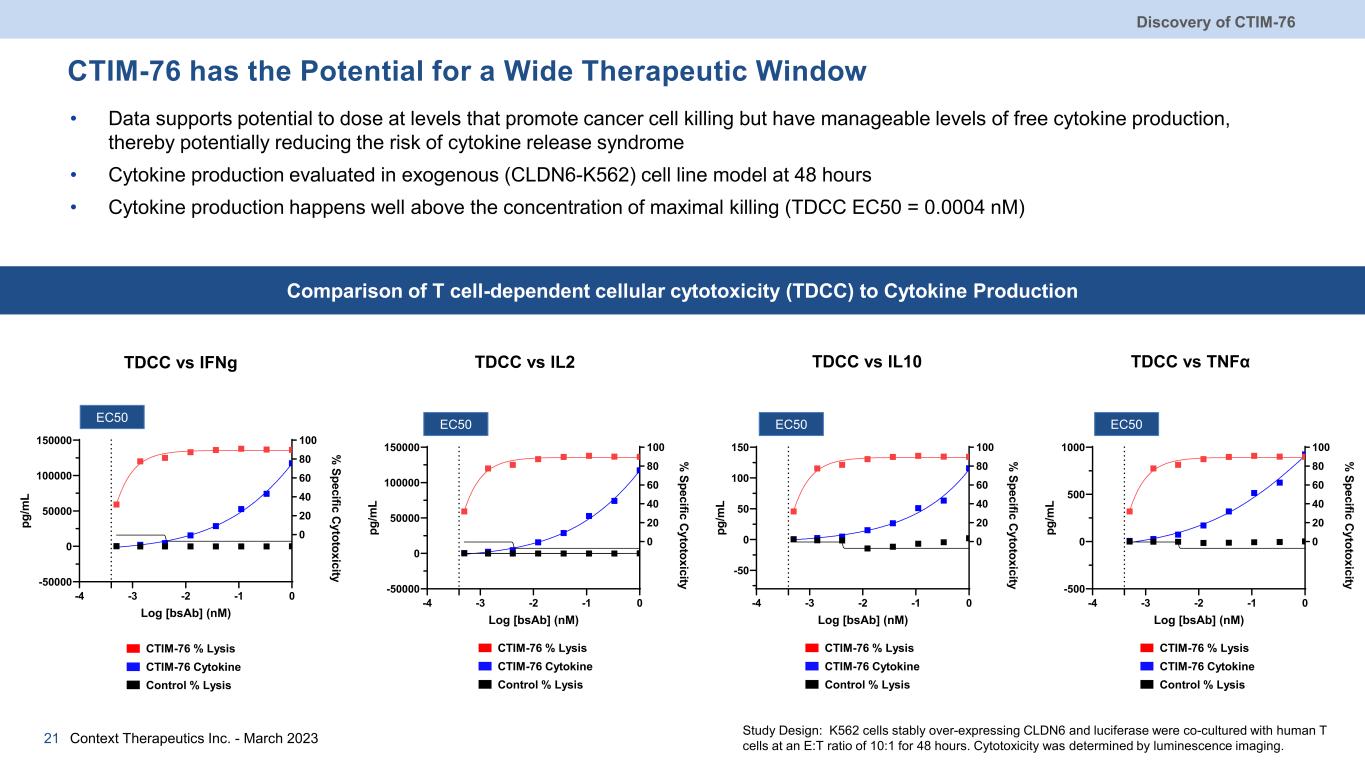
Discovery of CTIM-76 Context Therapeutics Inc. - March 202321 CTIM-76 has the Potential for a Wide Therapeutic Window • Data supports potential to dose at levels that promote cancer cell killing but have manageable levels of free cytokine production, thereby potentially reducing the risk of cytokine release syndrome • Cytokine production evaluated in exogenous (CLDN6-K562) cell line model at 48 hours • Cytokine production happens well above the concentration of maximal killing (TDCC EC50 = 0.0004 nM) CTIM-76 Cytokine Control % Lysis CTIM-76 % Lysis TDCC vs IL2 -4 -3 -2 -1 0 -50000 0 50000 100000 150000 0 20 40 60 80 100 Log [bsAb] (nM) pg /m L % Specific Cytotoxicity EC50 TDCC vs IFNg EC50 -4 -3 -2 -1 0 -50000 0 50000 100000 150000 0 20 40 60 80 100 Log [bsAb] (nM) pg /m L % Specific Cytotoxicity TDCC vs TNFα EC50 -4 -3 -2 -1 0 -500 0 500 1000 0 20 40 60 80 100 Log [bsAb] (nM) pg /m L % Specific Cytotoxicity TDCC vs IL10 EC50 -4 -3 -2 -1 0 -50 0 50 100 150 0 20 40 60 80 100 Log [bsAb] (nM) pg /m L % Specific Cytotoxicity Study Design: K562 cells stably over-expressing CLDN6 and luciferase were co-cultured with human T cells at an E:T ratio of 10:1 for 48 hours. Cytotoxicity was determined by luminescence imaging. CTIM-76 Cytokine Control % Lysis CTIM-76 % Lysis CTIM-76 Cytokine Control % Lysis CTIM-76 % Lysis CTIM-76 Cytokine Control % Lysis CTIM-76 % Lysis Comparison of T cell-dependent cellular cytotoxicity (TDCC) to Cytokine Production

Competitive Landscape 22 Context Therapeutics Inc. - March 2023
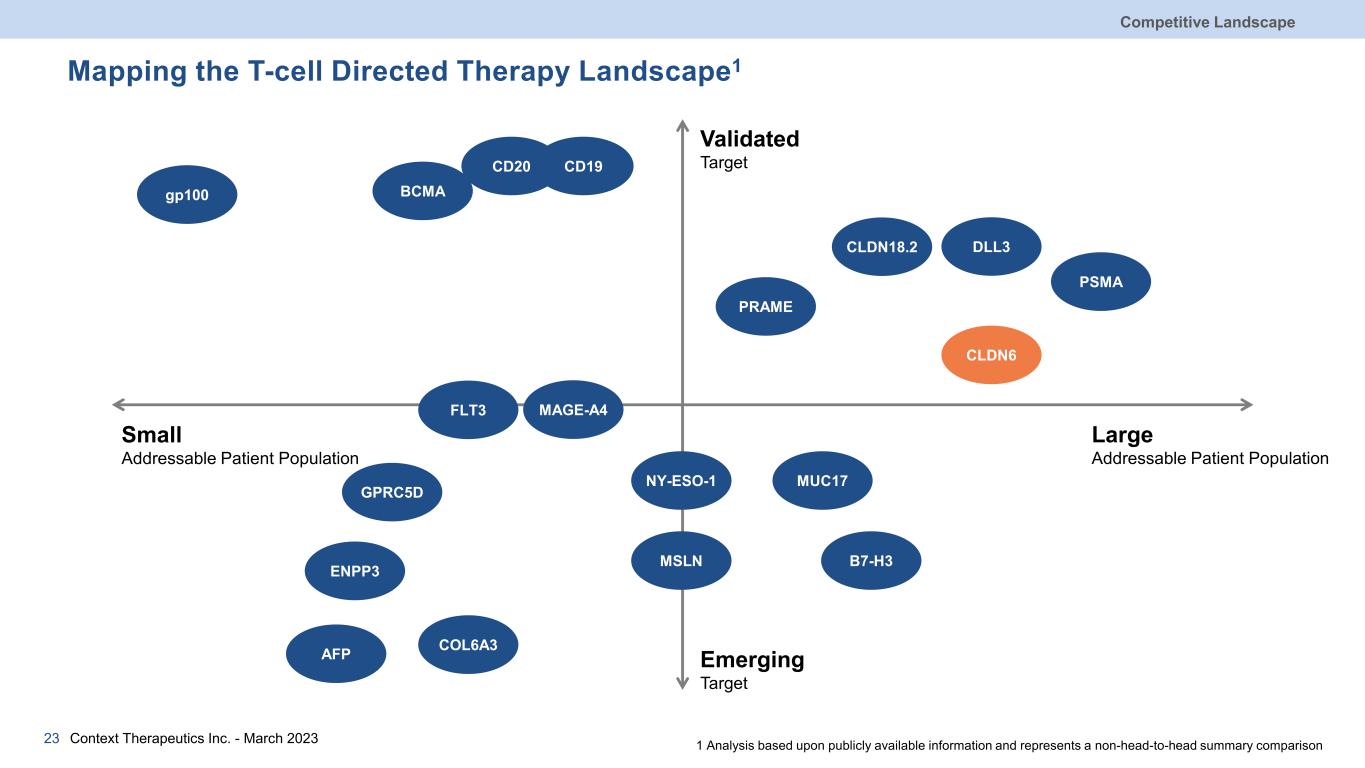
Mapping the T-cell Directed Therapy Landscape1 Competitive Landscape Context Therapeutics Inc. - March 202323 Large Addressable Patient Population Small Addressable Patient Population Validated Target Emerging Target PRAME MAGE-A4 CLDN6 CLDN18.2 NY-ESO-1 MSLN gp100 CD19 COL6A3AFP ENPP3 B7-H3 CD20 FLT3 BCMA GPRC5D DLL3 PSMA MUC17 1 Analysis based upon publicly available information and represents a non-head-to-head summary comparison

CLDN6 – Drug Development Strategy Comparison CLDN6 is a tumor-associated antigen (TAA) for tumor-targeting therapeutics such as CAR-T and T cell engaging bispecific antibodies Competitive Landscape Context Therapeutics Inc. - March 202324 Drug Development Strategy CLDN6 Dependence / Rationale Supporting Evidence Monoclonal Antibody (mAb) Receptor-mediated signaling Poor Weak signaling dependence1 Bispecific Antibody (bsAb) Cell surface antigen for T-cell targeting High In vivo PoC + BNT211 clinical PoC2,3 Antibody-Drug Conjugate (ADC) Receptor internalization Poor Weak internalization4 CAR-T Cell surface antigen for T-cell targeting High BNT211 clinical PoC3 1 https://www.clinicaltrialsregister.eu/ctr-search/trial/2013-002755-15/results . 2 Context internal 3 Haanen J, et al. AACR Annual Meeting 2022; Oral presentation CT002. 4 Data courtesy of Integral Molecular and Dr. Andrew Tsourkas (UPenn)

CLDN6 Competitive Landscape1 Programs differentiated based upon treatment modality and selectivity for CLDN6 over CLDN9 Competitive Landscape Context Therapeutics Inc. - March 202325 Preclinical Phase 1 Antibody Drug Conjugate (ADC) Bispecific Antibody Cell Therapy CLDN6-CAR-NK CAR-NK + IL7 (not disclosed) BNT211 CAR-T + CARVac (~7x) TJ-C64B 2+2 bsAb CLDN6x4IBB (not disclosed) UCLA-23-ADC CLDN6 + MMAE (~27x) AMG794 BiTE CLDN6xCD3 (~630x) BNT142 mRNA encoded BsAb CLDN6xCD3 (~7x) XmAb541 2+1 bsAb CLDN6xCD3 (~10x) SAIL66 bsAb CLDN6xCD3 (~10x) DS-9606a CLDN6/CLDN9 + DXd (~1x, non-selective) GB-7008-01 CLDN6/CLDN9 + MMAE (~1x, non-selective) 1 Analysis based on publicly available information compiled as of February 21, 2023 CTIM-76 bsAb CLDN6xCD3 (>1,000x)
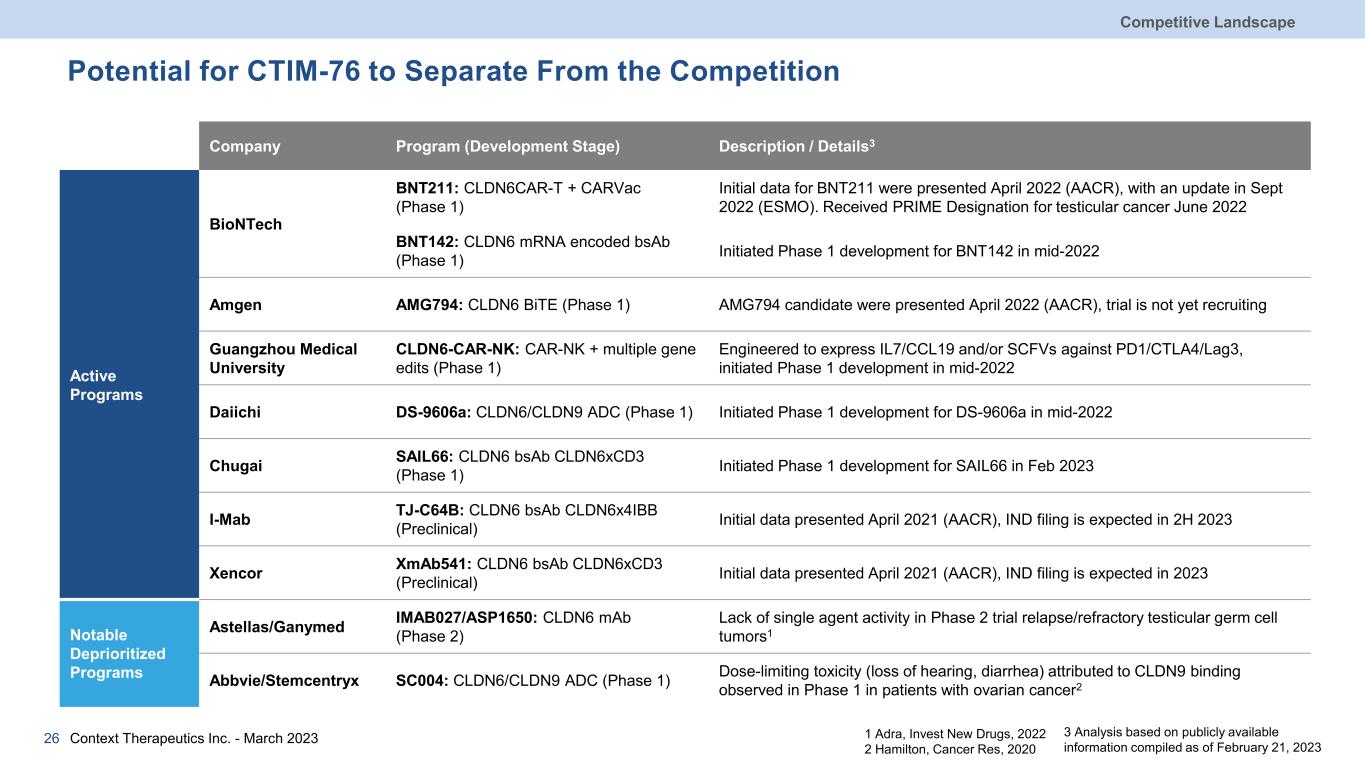
Potential for CTIM-76 to Separate From the Competition Company Program (Development Stage) Description / Details3 Active Programs BioNTech BNT211: CLDN6CAR-T + CARVac (Phase 1) Initial data for BNT211 were presented April 2022 (AACR), with an update in Sept 2022 (ESMO). Received PRIME Designation for testicular cancer June 2022 BNT142: CLDN6 mRNA encoded bsAb (Phase 1) Initiated Phase 1 development for BNT142 in mid-2022 Amgen AMG794: CLDN6 BiTE (Phase 1) AMG794 candidate were presented April 2022 (AACR), trial is not yet recruiting Guangzhou Medical University CLDN6-CAR-NK: CAR-NK + multiple gene edits (Phase 1) Engineered to express IL7/CCL19 and/or SCFVs against PD1/CTLA4/Lag3, initiated Phase 1 development in mid-2022 Daiichi DS-9606a: CLDN6/CLDN9 ADC (Phase 1) Initiated Phase 1 development for DS-9606a in mid-2022 Chugai SAIL66: CLDN6 bsAb CLDN6xCD3 (Phase 1) Initiated Phase 1 development for SAIL66 in Feb 2023 I-Mab TJ-C64B: CLDN6 bsAb CLDN6x4IBB (Preclinical) Initial data presented April 2021 (AACR), IND filing is expected in 2H 2023 Xencor XmAb541: CLDN6 bsAb CLDN6xCD3 (Preclinical) Initial data presented April 2021 (AACR), IND filing is expected in 2023 Notable Deprioritized Programs Astellas/Ganymed IMAB027/ASP1650: CLDN6 mAb (Phase 2) Lack of single agent activity in Phase 2 trial relapse/refractory testicular germ cell tumors1 Abbvie/Stemcentryx SC004: CLDN6/CLDN9 ADC (Phase 1) Dose-limiting toxicity (loss of hearing, diarrhea) attributed to CLDN9 binding observed in Phase 1 in patients with ovarian cancer2 Competitive Landscape 26 1 Adra, Invest New Drugs, 2022 2 Hamilton, Cancer Res, 2020 3 Analysis based on publicly available information compiled as of February 21, 2023Context Therapeutics Inc. - March 2023

Corporate 27 Context Therapeutics Inc. - March 2023
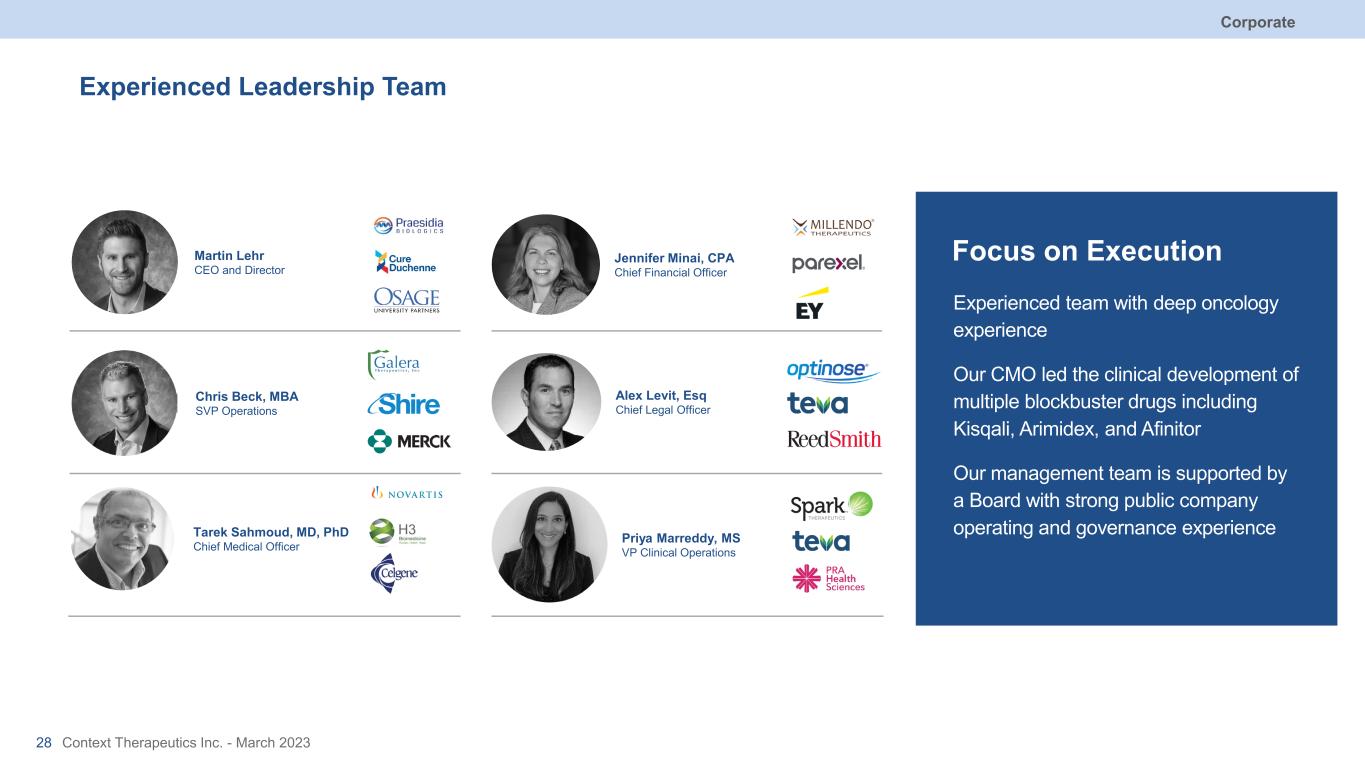
Corporate Experienced Leadership Team • Experienced team with deep oncology experience • Our CMO led the clinical development of multiple blockbuster drugs including Kisqali, Arimidex, and Afinitor • Our management team is supported by a Board with strong public company operating and governance experience Focus on Execution Martin Lehr CEO and Director Tarek Sahmoud, MD, PhD Chief Medical Officer Alex Levit, Esq Chief Legal Officer Jennifer Minai, CPA Chief Financial Officer Chris Beck, MBA SVP Operations Priya Marreddy, MS VP Clinical Operations Context Therapeutics Inc. - March 202328
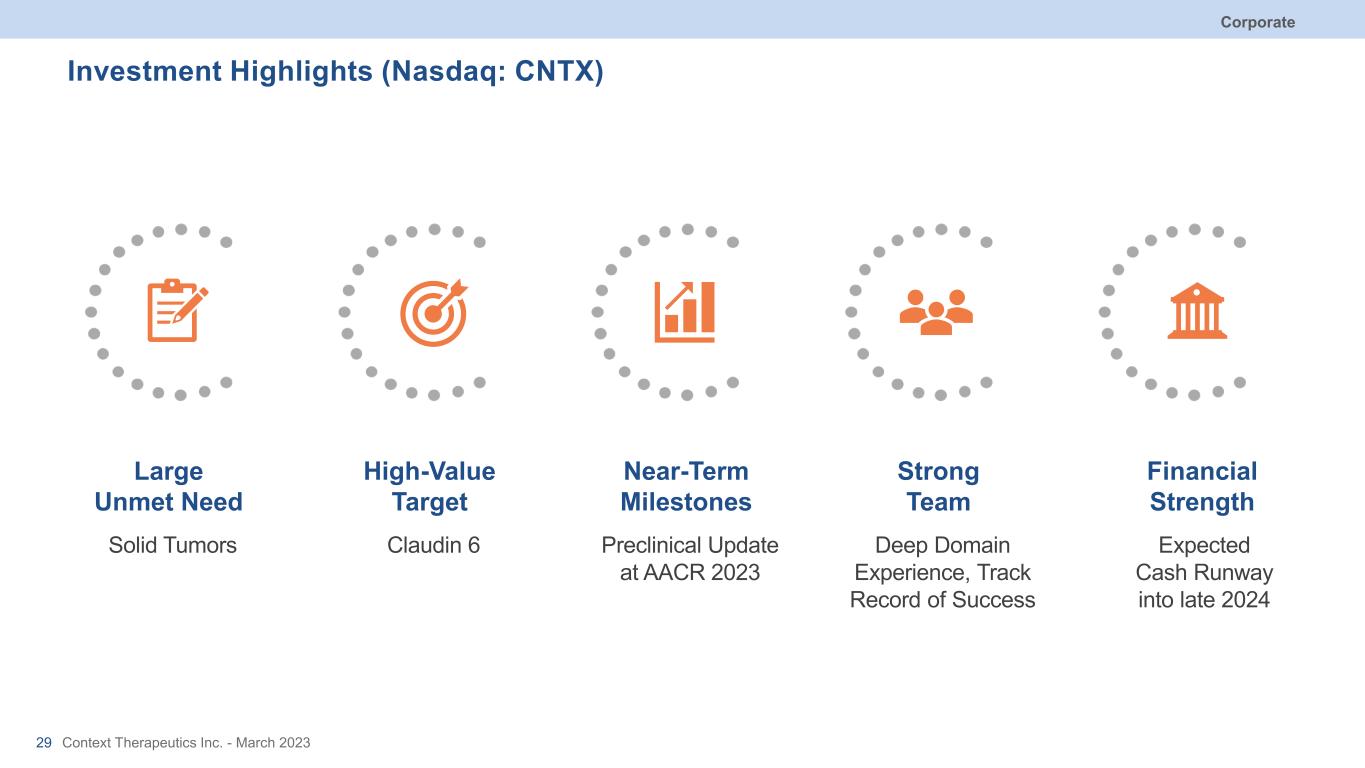
Corporate Investment Highlights (Nasdaq: CNTX) Solid Tumors Large Unmet Need Claudin 6 High-Value Target Preclinical Update at AACR 2023 Near-Term Milestones Deep Domain Experience, Track Record of Success Strong Team Expected Cash Runway into late 2024 Financial Strength Context Therapeutics Inc. - March 202329

Advancing Medicines for Solid Tumors © Context Therapeutics 2023





























